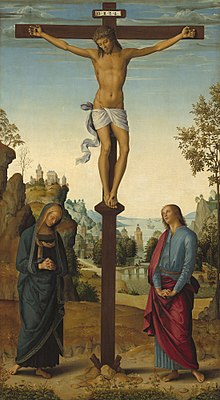Stabat Mater

The Stabat Mater is a 13th-century Catholic hymn to Mary, which portrays her suffering as Jesus Christ's mother during his crucifixion. Its author may be either the Franciscan friar Jacopone da Todi or Pope Innocent III.[1][2][3] The title comes from its first line, Stabat Mater Dolorosa, which means "the sorrowful mother was standing".[4]
The hymn is sung at the liturgy on the memorial of Our Lady of Sorrows. The Stabat Mater has been set to music by many Western composers, most famously by Palestrina (~1590), Vivaldi (1712), Domenico (1715) and Alessandro Scarlatti (1723), Pergolesi (1736), Joseph Haydn (1767), Rossini (1831-42), Dvořák (1876–77), Verdi (1896-97), Karol Szymanowski (1925–26), Poulenc (1950) and Arvo Pärt (1985).
Date
The Stabat mater is generally ascribed to Jacopo da Todi (ca. 1230-1306).
The Stabat Mater was well known by the end of the 14th century and Georgius Stella wrote of its use in 1388, while other historians note its use later in the same century. In Provence, about 1399, it was used during the nine days processions.[5]
As a liturgical sequence, the Stabat Mater was suppressed, along with hundreds of other sequences, by the Council of Trent, but restored to the missal by Pope Benedict XIII in 1727 for the Feast of the Seven Dolours of the Blessed Virgin Mary.[6]
Text and translation
The following translation by Edward Caswall is not word-for-word. Instead it has been adapted so as to represent the meter (trochaic tetrameter), rhyme scheme, and sense of the original text.
| Part of a series on the |
| Mariology of the Catholic Church |
|---|
 |
|
|
|
Stabat mater dolorósa |
At the Cross her station keeping, |
Musical settings
| Part of a series on the |
| Mariology of the Catholic Church |
|---|
 |
|
|
Notable composers who have written settings of the Stabat Mater include:
- Tilge, Höchster, meine Sünden, a parody by Johann Sebastian Bach of Pergolesi's Stabat (~1745/1747)
- Stabat Mater by Luigi Boccherini (1781, 1801)
- Stabat Mater by Antonio Caldara (~1725)
- Stabat Mater by Antonín Dvořák written when he was still active in writing secular music (1876–1877)and after the deaths of his young children.
- Stabat Mater by Joseph Haydn (1767)
- Stabat Mater by Franz Liszt, as part of the oratorio Christus (1862–1866)
- Stabat Mater by Giovanni Pierluigi da Palestrina (~1590)
- Stabat Mater by Arvo Pärt (1985)
- Stabat Mater by Giovanni Battista Pergolesi (1736)
- Stabat Mater by Francis Poulenc (1950)
- Stabat Mater by Gioachino Rossini (1831–1841), written after retiring from the composition of opera
- Stabat Mater by Domenico Scarlatti (1715)
- Stabat Mater by Alessandro Scarlatti (1723)
- Stabat Mater by Karol Szymanowski (1925–1926)
- Stabat Mater by Franz Schubert (G minor: 1815, F minor: 1816)
- Stabat Mater by Giuseppe Verdi (1896–1897)
- Stabat Mater by Antonio Vivaldi (1712)
Franz Schubert composed two settings of the sequence, the G minor setting and the F minor setting.
Others, not listed above, include:
- Metropolitan Hilarion (Grigoriy Valerievich Alfeyev)
- the black metal band Anorexia Nervosa
- Emanuele d'Astorga (1707)
- Paul Bebenek[citation needed]
- Franz Ignaz Beck (1782)
- Lennox Berkeley (1947)
- John Browne
- Pasquale Cafaro
- Marc-Antoine Charpentier (1680)
- Giovanni Carlo Maria Clari
- Peter Cornelius (1849)
- Bruno Coulais (2005)
- Johann Nepomuk David (1927)
- Pedro de Escobar
- the symphonic metal band Epica on the live albums The Classical Conspiracy and Retrospect
- Frank Ferko (1999)
- Charles Gounod
- Herbert Howells
- Karl Jenkins (2008)
- Zoltán Kodály
- Toivo Kuula[citation needed]
- Trond Kverno (1991)
- Lanza[citation needed]
- Orlande de Lassus (1585)
- Stefano Lentini included in the film The Grandmasters by Wong Kar-Wai.
- Christophe Looten
- Pawel Lukaszewski (1994)
- Stabat Mater, ballet by Peter Martins
- Vladimir Martynov (1994)
- Paul Mealor
- Neukomm[citation needed]
- Knut Nystedt
- George Oldroyd (1922)
- Stephen Paulus
- Krzysztof Penderecki
- Charles Villiers Stanford
- Josquin des Prez
- Josef Rheinberger
- Giovanni Felice Sances (1643)
- Agostino Steffani (1727)
- František Tůma
- Vladimír Godár (2001)
- Vito[citation needed]
- Winter[citation needed]
Most of the settings are in Latin, but Karol Szymanowski's and Paul Bebenek's are in Polish, although Szymanowski's may also be sung in Latin. George Oldroyd's setting is in Latin but includes an English translation for Anglican/Episcopalian use. The Alfeyev setting is in Russian.
See also
References
- ^ Sabatier, Paul Life of St. Francis Assisi Charles Scribner Press, NY, 1919, page 286
- ^ The seven great hymns of the Mediaeval Church by Charles Cooper Nott 1868 ASIN: B003KCW2LA page 96
- ^ p. 574, Alighieri, Durling, Martinez (2003) Dante, Robert M., Ronald L. Oxford The Divine Comedy of Dante Alighieri: Purgatorio Volume 2 of The Divine Comedy of Dante Alighieri Oxford University Press. "The Stabat Mater by the Franciscan Jacopone da Todi."
- ^ Stabat Mater, Volume 68 by Girolamo Abos, Joseph Vella Bondin 2003 ISBN 0-89579-531-0 page xviii [1]
- ^ Catholic encyclopedia
- ^ Heartz, Daniel (1995). Haydn, Mozart and the Viennese School: 1740-1780. W.W. Norton & Co. p. 305. ISBN 0-393-03712-6. Retrieved 3 April 2011.
{{cite book}}: Cite has empty unknown parameter:|coauthors=(help)
 This article incorporates text from a publication now in the public domain: Herbermann, Charles, ed. (1913). "Stabat Mater". Catholic Encyclopedia. New York: Robert Appleton Company.
This article incorporates text from a publication now in the public domain: Herbermann, Charles, ed. (1913). "Stabat Mater". Catholic Encyclopedia. New York: Robert Appleton Company.
External links
- Website about (now) 250 different Stabat Mater compositions: information about the composers, the music and the text. The site also includes translations of the text in 20 languages.
- Several English translations
- Chant performed by "Exsurge Domine" vocal ensemble.
- Karol Szymanowski's "Stabat Mater". Spanish Radio and Television Symphony Orchestra. Thomas Dausgaard, conductor. Live concert.
